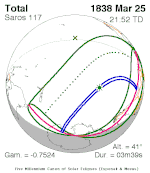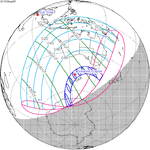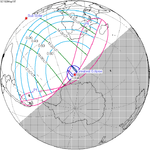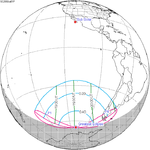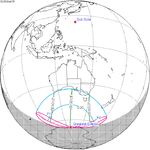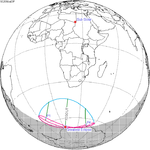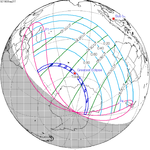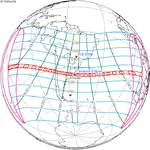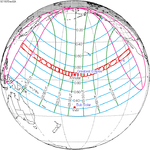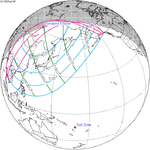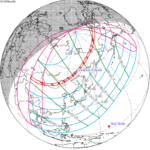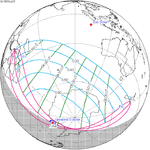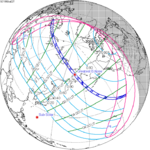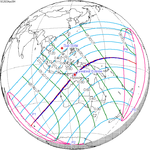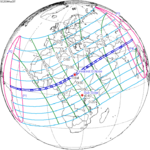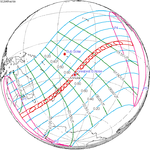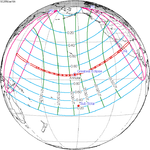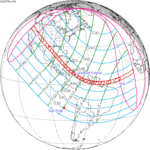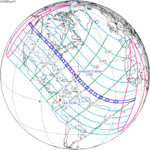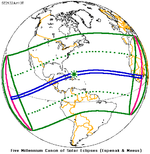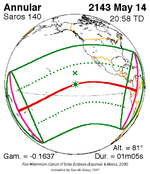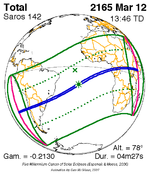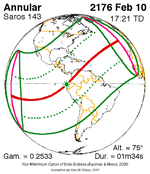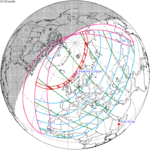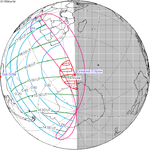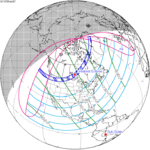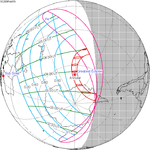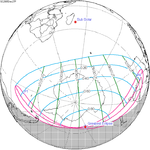|
Solar eclipse of April 26, 1892
A total solar eclipse occurred at the Moon's ascending node of orbit on Tuesday, April 26, 1892, with a magnitude of 1.0591. A solar eclipse occurs when the Moon passes between Earth and the Sun, thereby totally or partly obscuring the image of the Sun for a viewer on Earth. A total solar eclipse occurs when the Moon's apparent diameter is larger than the Sun's, blocking all direct sunlight, turning day into darkness. Totality occurs in a narrow path across Earth's surface, with the partial solar eclipse visible over a surrounding region thousands of kilometres wide. Occurring only about 13 hours after perigee (on April 26, 1892, at 9:10 UTC), the Moon's apparent diameter was larger.[1] DescriptionThe eclipse was visible in many parts of the South Pacific Ocean. Very few portions occurred over land including New Zealand except for Auckland and the northernmost portion of North Island, islands such as the Chatham Islands, Antipodes, Marquesas Tahiti and Tuamotu, the westernmost fringes of the Antarctica including its peninsula and the westernmost areas of South America including most of the Andes Mountains in Chile, westernmost Argentina, much of Peru, the southwesternmost of Colombia and Ecuador especially the Galapagos.[2] It was part of solar saros 117.[3] The umbral portion which was as far as 414 km (257 mi) and started at the peninsular portion of Antarctica, the rest was in the Pacific Ocean. The greatest occurred in the Pacific Ocean at 42.5 S & 119.4 W at 21:55 UTC (1:55 PM local time) and lasted for over 4 minutes.[2] The eclipse was up to around 20% obscured in many parts of New Zealand and around 10% in Tahiti. The eclipse started at sunrise in New Zealand and finished at sunset in South America mainly at a part of the Andes Mountains. The eclipse was obscured by clouds in Dunedin.[4][5] It was visible from Timaru further north,[6] but was not visible due to clouds on Banks Peninsula.[7] Wellington also experienced heavy cloud cover and the eclipse was thus not visible.[8] The subsolar marking was at around the 15th parallel north southeast of Hawaii and northeast of the Palmyra Atoll. Eclipse detailsShown below are two tables displaying details about this particular solar eclipse. The first table outlines times at which the moon's penumbra or umbra attains the specific parameter, and the second table describes various other parameters pertaining to this eclipse.[9]
Eclipse seasonThis eclipse is part of an eclipse season, a period, roughly every six months, when eclipses occur. Only two (or occasionally three) eclipse seasons occur each year, and each season lasts about 35 days and repeats just short of six months (173 days) later; thus two full eclipse seasons always occur each year. Either two or three eclipses happen each eclipse season. In the sequence below, each eclipse is separated by a fortnight.
Related eclipsesEclipses in 1892
Metonic
Tzolkinex
Half-Saros
Tritos
Solar Saros 117
Inex
Triad
Solar eclipses of 1892–1895This eclipse is a member of a semester series. An eclipse in a semester series of solar eclipses repeats approximately every 177 days and 4 hours (a semester) at alternating nodes of the Moon's orbit.[10] The partial solar eclipse on August 20, 1895 occurs in the next lunar year eclipse set.
Saros 117This eclipse is a part of Saros series 117, repeating every 18 years, 11 days, and containing 71 events. The series started with a partial solar eclipse on June 24, 792 AD. It contains annular eclipses from September 18, 936 AD through May 14, 1333; hybrid eclipses from May 25, 1351 through July 8, 1423; and total eclipses from July 18, 1441 through May 19, 1928. The series ends at member 71 as a partial eclipse on August 3, 2054. Its eclipses are tabulated in three columns; every third eclipse in the same column is one exeligmos apart, so they all cast shadows over approximately the same parts of the Earth. The longest duration of annularity was produced by member 16 at 9 minutes, 26 seconds on December 3, 1062, and the longest duration of totality was produced by member 62 at 4 minutes, 19 seconds on April 26, 1892. All eclipses in this series occur at the Moon’s ascending node of orbit.[11]
Metonic seriesThe metonic series repeats eclipses every 19 years (6939.69 days), lasting about 5 cycles. Eclipses occur in nearly the same calendar date. In addition, the octon subseries repeats 1/5 of that or every 3.8 years (1387.94 days). All eclipses in this table occur at the Moon's ascending node.
Tritos seriesThis eclipse is a part of a tritos cycle, repeating at alternating nodes every 135 synodic months (≈ 3986.63 days, or 11 years minus 1 month). Their appearance and longitude are irregular due to a lack of synchronization with the anomalistic month (period of perigee), but groupings of 3 tritos cycles (≈ 33 years minus 3 months) come close (≈ 434.044 anomalistic months), so eclipses are similar in these groupings.
Inex seriesThis eclipse is a part of the long period inex cycle, repeating at alternating nodes, every 358 synodic months (≈ 10,571.95 days, or 29 years minus 20 days). Their appearance and longitude are irregular due to a lack of synchronization with the anomalistic month (period of perigee). However, groupings of 3 inex cycles (≈ 87 years minus 2 months) comes close (≈ 1,151.02 anomalistic months), so eclipses are similar in these groupings.
See alsoReferences
External links |
|||||||||||||||||||||||||||||||||||||||||||||||||||||||||||||||||||||||||||||||||||||||||||||||||||||||||||||||||||||||||||||||||||||||||||||||||||||||||||||||||||||||||||||||||||||||||||||||||||||||||||||||||||||||||||||||||||||||||||||||||||||||||||||||||||||||||||||||||||||||||












